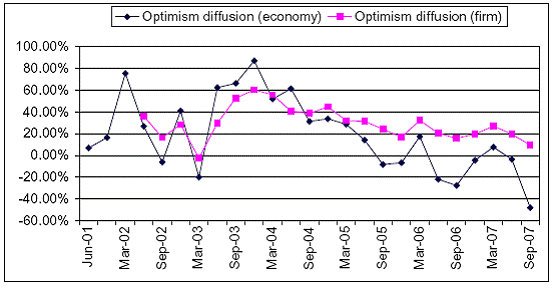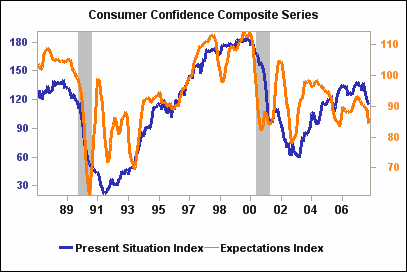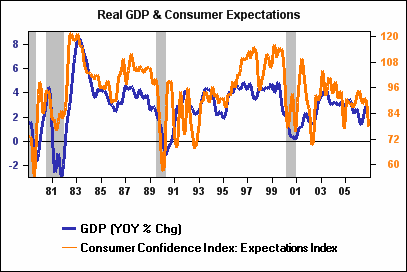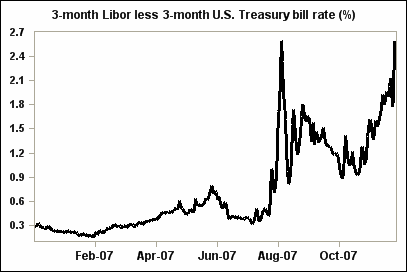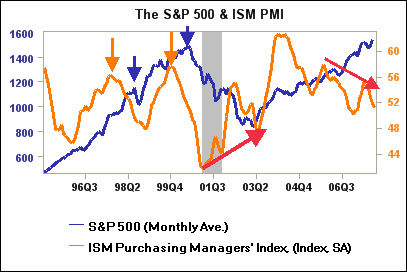No matter where you look, whether it's business sentiment, consumer sentiment, or even foreign sentiment, expectations and confidence are falling by the wayside and sharply. Despite the strong deterioration in confidence, many financial pundits and economists remain optimistic in their future growth projections for the US economy, and Fed Chairman Bernanke is no different.

Source: R.J. Matson, Roll Call 2007
However, the messages sent by those who exercise their vote with their wallets and balance sheets are far less optimistic. This is of great concern because a widespread loss of confidence typically brings about a recession. This arises because as businesses become pessimistic on the future economic outlook, they reduce spending and hiring and cut back on their appetite for debt. Moreover, as confidence falls, credit markets become more risk averse and credit begins to dry up, driving up borrowing costs with the final blow being consumers curtailing spending.
The loss in business confidence really took a turn for the worse after the start of the recent credit crisis. For example, the Duke/CFO Magazine Global Business Outlook Survey's results for the third quarter showed the nation's CFOs have turned quite sour on the economy as well as their own businesses. Quotes and statistics from the latest survey are provided below (September 2007 Results):
Optimism about the US economy plunged to a record low this quarter among chief financial officers. CFOs expect slow growth in earnings, capital spending and acquisitions and no growth in hiring (emphasis added). They are very concerned about weak consumer demand, rising labor costs and credit markets.
SUMMARY OF SURVEY FINDINGS:
--Optimism reached its lowest point since the optimism index launched six years ago (emphasis added). Pessimists outnumber optimists by roughly a four-to-one margin, with 61.7 percent of CFOs more pessimistic and only 13.6 percent more optimistic about the US economy than they were last quarter.
--Capital spending is expected to increase only 3.2 percent, and domestic employment will be flat, though outsourced employment should rise 5.9 percent.
--Weak consumer demand, high labor costs and credit market turmoil rank among the top concerns of CFOs.
Other Key Results from September 2007 survey
--31% of CFOs say their firm has been affected by recent credit market turmoil. Among these firms
58% have experienced a higher cost of borrowing (72 basis points)
33% have experienced decreased availability of credit
31% are reducing capital spending plans in response
18% are reducing M&A plans in response
16% are reducing hiring plans in response--If the Fed were to lower the Fed Funds rate by 50 basis points
44.5% of firms say it would not help their ability to borrow
37.4% say it would help only a little
18.1% say it would help a moderate amount or a lot--68.7% of firms say M&A has slowed or will slow this year. Among these firms,
86% say slowing will be due to tighter credit markets
63% say due to increased cost of borrowing
34% say due to weak economic growth--75% of firms expect acquisitions to shift away from private equity buyers towards corporate acquisitions
The CFO survey above highlights the widespread pessimism coming from those in charge of company pocketbooks. They are concerned about a weak consumer, rising labor costs, and the fallout from the credit markets, all of which will affect their business decisions going forward. One thing to note, the CFOs have a great pulse on the economy as they correctly called the bottom in economic activity where more than 80% were optimistic about the economy late in 2003, right when the stock markets bottomed and the economy picked up steam. What then does it say when their confidence levels are below levels seen in the last recession, and at all-time lows? Certainly not encouraging!
The Duke/CFO survey is corroborated by Moody's Survey of Business Confidence, which has fallen sharply since the credit crisis began in August, with the index falling to 7.2 last week (moving average shown below), its lowest level in the survey's five-year history. Commentary from the Mark Zandi, Chief Economist and co-founder of Moody's is provided below:
Figure 2
Source: Moody's, DismalScientist
Moody's Survey of Business Confidence
Global business sentiment slumped again last week and is consistent with a very fragile economy. This is especially true in the US where sentiment, if sustained, is consistent with recession.
Across the globe, the difference between the percentage of all positive responses and all negative responses to the various questions asked in the survey fell to 13% last week. The same measure was only 8% for US businesses. Readings between 25% and 30% are consistent with an economy that is expanding at potential. Survey readings below 10% are consistent with recession. The all-time peak was just below 40% at year-end 2005.
Businesses are particularly negative when responding to the survey's broader questions regarding current conditions and the six-month outlook. Assessments of current conditions stood at less than -24% on a four-week moving average basis, well below the previous low of -14% set in the midst of the Iraq invasion. Business expectations regarding the six-month outlook have also been more or less negative for the past more than two months, and fell to the lowest reading on record last week.
Businesses' caution is very evident as they are liquidating inventories and being more cautious in their demand for office space. The inventory drawdown is increasingly consistent with other broader measures of inventory investment, which have begun to weaken recently. The weaker office absorption is consistent with anecdotal reports from various property managers across the country.
Until the past couple of weeks, sentiment overseas was holding firm. European and South American businesses are turning notably more concerned. Asian confidence has also weakened, but is still measurably better. This erosion in overseas confidence bears close watching as a strong overseas economy has been important to any optimism regarding US trade and thus the ability of the economy to skirt recession.
In contrast to the strong global third quarter growth in real GDP, business confidence remains fragile and uncomfortably low. According to the survey results, the global economy will struggle in coming months and recession in the US appears increasingly likely.
The sentiment among consumers echoes the concerns of businesses, both domestic and abroad. As mentioned above, it is a widespread loss and deterioration of confidence that leads to a recession, with this characteristic shown clearly below from The Conference Board (TCB). The recent slip in confidence will raise the risk of recession if it continues to slide on the downside.
Consumer spending habits reflect their emotions, and when consumers lose confidence in the economy they curtail spending and the economy slows. This close-knit relationship is shown in the two figures below, with both confidence indices heading south and consumption trends following suit.
The relationship between consumer confidence and business confidence is quite clear and not hard to imagine. As consumers retrench spending habits due to a loss of confidence, business confidence and spending follow suit, and when both lose confidence and contract spending habits, the whole economy slows down and GDP growth falls.
Despite the broad-based deterioration in confidence, the markets began a rally last week and jumped today. One of the main articles appearing today in Yahoo Finance had the following title and subtitle, with an excerpt below:
Stocks Rally on Strong Economic Data: Stocks Soar As Investors Grow More Optimistic About Economy, Upcoming Interest Rate Cut
Stocks turned around following two sessions of losses after a report showed hiring in the US private sector expanded at a faster pace in November. ADP Employer Services said 189,000 jobs were added during the month — an increase that bodes well for consumer spending.
Some investors are betting the Fed will go beyond the generally anticipated quarter percentage point cut, and lower rates by a half point.
A little reality check is needed. For one, the ADP employment number, as well as the jobs report from the Labor Department (released Friday), is subject to major revisions. Anyone remember the August employment data from the Labor Department that showed a LOSS of more than 4,000 jobs that turned into a GAIN of 93,000 jobs when later revised? The most important thing to remember is the trend and no leading employment indicator has bottomed yet and so one should not turn optimistic on the job front. Temporary employment, which leads nonfarm employment, has not officially bottomed yet and is in fact in recession territory (below orange horizontal line).
Moving on and addressing the second point cited for the market's rally today—another Fed rate cut—let us just see how effective the last three Fed cuts have been to slow tensions in the credit markets, shall we? A few keys for monitoring the Fed's effectiveness would be the seizure in the commercial paper markets as well as yield spreads which measure fear, and to a degree, the cost of borrowing.
So how effective have the Fed's previous cuts been? Since the credit crisis began and after three Fed rate cuts, asset-backed commercial paper is lower than when it began, total commercial paper is lower, and credit spreads are either higher or back to their highs seen in August. In short, the Fed rate cuts have had no effect on either the credit markets or in calming investor fears as measured by yield spreads.
You hear about how the Fed is injecting liquidity into the system to support the markets; well this just isn't happening, at least not yet. Remember the CFO survey mentioned above? Of the 31% of the CFOs who said their firm has been affected by the credit crisis, 58% have experienced a higher cost of borrowing and 33% have experienced decreased availability of credit, indicating that firms are not gaining access to credit and benefiting from the rate cuts.
The markets have been oversold and were due for a rally, but put this snapback rally into proper perspective by listening to what both consumers and businesses are saying, which is not a vote of confidence. Listening to the message from other economic signals also makes the current rally suspect. For example, the ISM Purchasing Managers Index typically peaks prior to peaks in the S&P 500, and significant divergences (red arrows) between the two typically occur around turning points in the economy and markets.
Last but not least, two more indicators reflecting deteriorating economic fundamentals are rising delinquency rates that correlate strongly with unemployment rates, and a decline in manufacturing backlog of orders. Delinquency rates have jumped considerably this year and it would not be surprising to see the unemployment rate rise according to the historical script, which would be consistent with the CFO survey whose respondents said they were not planning on hiring anytime soon, at least not domestically that is. The decline in backlog orders indicates that the tailwind that propped up third quarter GDP—inventory build and exports—could turn into a headwind as many companies are liquidating their inventories amid weakness seen in the consumer.
Today's Market
As mentioned above, the markets rallied on positive economic news from the ADP Employer Service report and hopes of a 50 basis point cut from the Fed. The Dow Jones Industrial Average rose 196.23 points to close at 13444.96 (+1.48%), the S&P 500 gained 22.22 points to close at 1485.01 (+1.52%), and the NASDAQ rose 46.53 points to close at 2666.36 (+1.78%).
Treasuries fell with the yield on the 10-year note rising 2.2 basis points to close at 3.911%. The dollar index was up on the day, rising 0.74 points to close at 76.43. Advancing issues represented 73% and 64% for the NYSE and NASDAQ respectively, reflecting a broad rally in the markets.
